The Folding Society
The Brompton - Accessories and modifications
Do not attempt any job on your Brompton or any other cycle
yourself unless you have the knowledge and experience to do so -
inappropriate modifications, or incorrectly executed modifications could
endanger your and other people's safety.
Seat Post
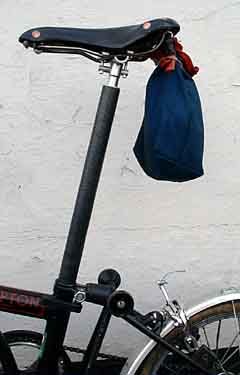 Taller riders (from about 5 foot 9 inches upwards) may well find that they
want the optional telescopic seatpost. This should suffice for people well
over 6 feet tall - there are a number of people happily riding Bromptons
who must be around 6 foot 6inches. A light weight carbon fibre seatpost is
also available from a third party, but at £120 it is only for those
who really want to minimise the weight of the bike and don't mind paying
to be able to do so.
Taller riders (from about 5 foot 9 inches upwards) may well find that they
want the optional telescopic seatpost. This should suffice for people well
over 6 feet tall - there are a number of people happily riding Bromptons
who must be around 6 foot 6inches. A light weight carbon fibre seatpost is
also available from a third party, but at £120 it is only for those
who really want to minimise the weight of the bike and don't mind paying
to be able to do so.
Front mounting block/Carrier/bag
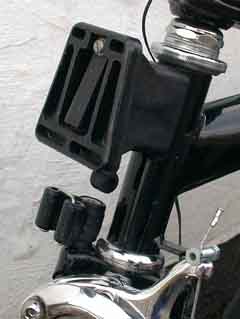 The
superb luggage system, which does not interfere with the first step in
parking and folding a Brompton, and which clips on and off in seconds, is
one of the great strengths of the Brompton design. So you will certainly
want to buy the optional mounting block. You can buy a bare front carrier
chassis and mount your own bag on it, though most people choose to buy the
standard Brompton bag to go with it. This is very versatile and quite
smart looking, though not very waterproof. The carrier chassis provides a
very convenient handle for carrying the chassis and bag when they are
taken off the bike. Brompton now have several bags available to
suit the bike, and it seems likely that the new touring bag will
become popular. It is reported to have larger capacity and more
storage pockets than the older standard bag, which remains
available. One problem with the older bag at least was that it was
not very water resistant. Brompton now have a waterproof cover
available to slip over the bag.
The
superb luggage system, which does not interfere with the first step in
parking and folding a Brompton, and which clips on and off in seconds, is
one of the great strengths of the Brompton design. So you will certainly
want to buy the optional mounting block. You can buy a bare front carrier
chassis and mount your own bag on it, though most people choose to buy the
standard Brompton bag to go with it. This is very versatile and quite
smart looking, though not very waterproof. The carrier chassis provides a
very convenient handle for carrying the chassis and bag when they are
taken off the bike. Brompton now have several bags available to
suit the bike, and it seems likely that the new touring bag will
become popular. It is reported to have larger capacity and more
storage pockets than the older standard bag, which remains
available. One problem with the older bag at least was that it was
not very water resistant. Brompton now have a waterproof cover
available to slip over the bag.
The front bag is so good and so easy to use that there is a temptation
to use it all the time - do be aware that the weight and aerodynamics of
the bag have an effect on its performance. You won't have any problems
riding with it fitted, even with as much weight as you can get in the bag,
but it's noticeable how much more lively the bike feels without it. So use
the bag when you need it, but if you don't need it, you'll find the bike
even more fun to ride without it. An alternative which was developed
recently by the ever inventive Steve Parry is a small
bracket which can be easily screwed to a conventional handlebar bag
of the type which has a rigid interior (such as those used with the
Klik-Fix mounting system) and which attaches to the standard Brompton
front mounting block. This makes for a much lighter and more aerodynamic
bag, and although it is of much smaller capacity than the standard
Brompton one, it is adequate for many rides.
A small saddle bag, or the bag supplied for carrying the cover, can be
used for carrying a few tools, spare tube, cover etc on days when there is
no other load to be carried.
Cover
The Brompton is so neat when folded that it is often unnecessary to
cover it - personally I have never had a train conductor object to the
folded bike, even when it is not covered as technically it should be on
some trains. However, it's useful to have a cover to hand if it is needed,
or perhaps for taking the bike into somewhere like an office. In this
situation the cover is there to conceal the bike, rather than protect it
from damage. The Brompton bag does this adequately, but it is something of
an overkill for this purpose, and it is quite bulky when folded. Some
people carry a large dustbin bag to cover the bike if needed (it needs to
be larger than standard bin bags), and this is cheap, light and small when
packed, though easily damaged and difficult to fold after use.
Please note that the alternative cover which used to be available
from A to B is no longer being made.
For carrying the bike on planes, a case is really desirable to protect
it. In the USA, Channel
Wasson, the distributor there, offers a case which will hold
the bike when folded, and which can be towed behind the bike, and
some people have managed to find other cases suitable for carrying
the bike. There is no case currently available from Brompton
themselves, though they do offer a soft bag for the purpose. This
does not provide the protection of a case, but it can be folded
into a resonably small package to carry after use.
Tyres
The Brompton used to come as standard with the Raleigh Record
tyre, and this is still the standard tyre for the Companion model.
The other models are now fitted as standard with the new Brompton
tyre - reported to have much better rolling resistance, and no
drawbacks. As an option there is a Kevlar belted version of this
tyre (better puncture resistance, but probably higher rolling
resistance) or alternatively the excellent Schwalbe Marathon -
good rolling resistance, good puncture resistance and good grip.
Prior to the introduction of the Brompton and Schwalbe tyres, many
owners fitted the Primo tyre, which is still probably the best for
rolling resistance, and which dramatically improved the bikes
performance compared with the Raleigh Record. When it originally
became available, the Primo was been voted the best accessory/add-on for the
Brompton. The Raleigh record is probably best avoided now, but
any of the other tyres should give satisfaction.
Bar ends
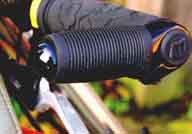 One
drawback of the Brompton for most people is the rather upright riding
position, influenced both by the height of the handlebars and the nearness
to the saddle. Even if the extension piece which moves the saddle closer
to the bars is removed and the saddle is mounted directly to the seatpin
(as in normal cycles - the extension just makes the folded Brompton
slightly more compact), the bars are still too close for most riders. The
bars cannot be swivelled forward much without interfering with the
folding, and swivelling them whenever the bike is folded and unfolded is
highly undesirable - it is likely to scratch the bars and result in
weakening of them; a handlebar breakage is very unpleasant and potentially
dangerous. The best solution if you want to improve the riding position
slightly, and at the same time give an alternative hand position on the
bars, which reduces strain on longer rides - is to fit bar end extensions.
Normal mountain bar extensions are too long and will interfere with
folding, but the Super Stubbie model (shown in the photograph, but fitted
here to a Birdy!) sold by Avon
Valley Cyclery is ideal, and indeed is intended specifically for the
Brompton. Although very short, it does improve the riding position
noticeably. The rubber cover over the bar ends is not standard - I use
these not to improve grip but to prevent my hands getting cold in the
winter. The only thing you should be aware of is that if you pull on the
bars when hill climbing, the extra leverage which you will get while
holding these extensions does make the long upright handlebar stem flex
much more noticeably.
One
drawback of the Brompton for most people is the rather upright riding
position, influenced both by the height of the handlebars and the nearness
to the saddle. Even if the extension piece which moves the saddle closer
to the bars is removed and the saddle is mounted directly to the seatpin
(as in normal cycles - the extension just makes the folded Brompton
slightly more compact), the bars are still too close for most riders. The
bars cannot be swivelled forward much without interfering with the
folding, and swivelling them whenever the bike is folded and unfolded is
highly undesirable - it is likely to scratch the bars and result in
weakening of them; a handlebar breakage is very unpleasant and potentially
dangerous. The best solution if you want to improve the riding position
slightly, and at the same time give an alternative hand position on the
bars, which reduces strain on longer rides - is to fit bar end extensions.
Normal mountain bar extensions are too long and will interfere with
folding, but the Super Stubbie model (shown in the photograph, but fitted
here to a Birdy!) sold by Avon
Valley Cyclery is ideal, and indeed is intended specifically for the
Brompton. Although very short, it does improve the riding position
noticeably. The rubber cover over the bar ends is not standard - I use
these not to improve grip but to prevent my hands getting cold in the
winter. The only thing you should be aware of is that if you pull on the
bars when hill climbing, the extra leverage which you will get while
holding these extensions does make the long upright handlebar stem flex
much more noticeably.
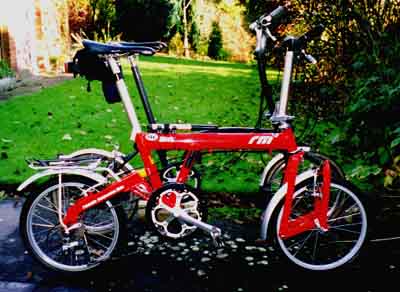 The
problem(??) of the riding position: This picture shows a Birdy alongside a
Brompton: PLEASE note that the Brompton is behind the Birdy, and
perspective exaggerates the differences, particularly as this was taken
with a wide angle lens on the camera. Still, you can see why anyone who
likes the Birdy riding position won't be comfortable with a Brompton (and
equally of course vice versa). Personally I find the Birdy has a slightly
too long reach and the bars are slightly too low, but they are very close
to the ideal for me. That means I'm not altogether happy with the Brompton
riding position, but in saying this bear in mind that I am a short (5 foot
6 inches) male with rather short legs. Riders of different height, and
different proportions, may have different views regarding which is better,
and anyway 'ideal' riding position is very much a question of taste. While
both designs have their merits, I think the Brompton is a superb device,
and, although there undoubtedly improvements that could, and should, be
made, I'd never want to be without one.
The
problem(??) of the riding position: This picture shows a Birdy alongside a
Brompton: PLEASE note that the Brompton is behind the Birdy, and
perspective exaggerates the differences, particularly as this was taken
with a wide angle lens on the camera. Still, you can see why anyone who
likes the Birdy riding position won't be comfortable with a Brompton (and
equally of course vice versa). Personally I find the Birdy has a slightly
too long reach and the bars are slightly too low, but they are very close
to the ideal for me. That means I'm not altogether happy with the Brompton
riding position, but in saying this bear in mind that I am a short (5 foot
6 inches) male with rather short legs. Riders of different height, and
different proportions, may have different views regarding which is better,
and anyway 'ideal' riding position is very much a question of taste. While
both designs have their merits, I think the Brompton is a superb device,
and, although there undoubtedly improvements that could, and should, be
made, I'd never want to be without one.
Handlebar stem
The handlebars on the Brompton are mounted rather high and
close to the rider. Shorter riders would for the most part prefer
the bars lower, while some very tall riders might prefer them
higher. Steve Parry's SP Bromptons are
fitted with a suspension seatpost which carries more conventional
handlebars, and allows the height to be adjusted. In addition,
this does not flex in the way that the standard Brompton bars do,
but it gives better insulation from road vibration. Although Steve
only supplies this system as part of a complete SP, Kinetics
are now producing something similar which can be retrofitted to
existing Bromptons, and they also have a telescopic stem
arrangement available to allow extra or less height and some
adjustment of the reach.
Rear Mud Flap
Owners
of old Bromptons found the absence of a mud flap a severe
problem - their backs got very wet as soon as the roads were damp.
However, a mudflap is now standard on all those models fitted with
mudguards (ie all except the Companion).
Improving the brakes
Most
people found the brakes on the Brompton prior to March 2000 less than inspiring.
Some owners modified the bikes by fitting a dual pivot Alhonga
instead, or even made the more complicated change to V-brakes. The
new brakes now fitted to all Bromptons (except the Companion)
should satisfy most owners, although they would probably benefit
(like most production bikes) from a change to better brake blocks,
such as the Aztec blocks. The new brakes and levers are now
available for retro-fitting to older Bromptons, and should be
obtainable via any Brompton dealer.
The Brompton Trailer bike
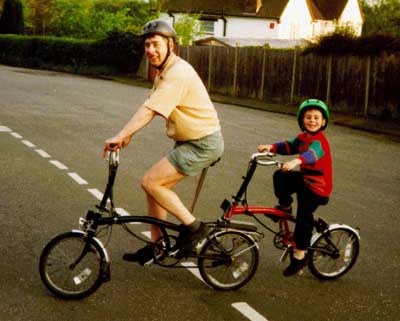 The
following article on a novel Brompton modification was kindly supplied by
Andrew Holland. Please note the
usual warnings and disclaimers about making modifications to your or
anybody elses bicycle(s).
The
following article on a novel Brompton modification was kindly supplied by
Andrew Holland. Please note the
usual warnings and disclaimers about making modifications to your or
anybody elses bicycle(s).
With two Bromptons and child seat life was OK. As a 4-year-old became a
5-year-old then a 6-year old boy it got progressively harder getting up
the hills. "Daddy why don't you talk to me ?" says Clement "Gasp
Gasp" goes Daddy
One of the many good things from the Folder forums was the try other
people's bikes out so Clement & I had a test ride on a conventional
Trailer Bike. Just the job Clement can contribute to the pedal power. As
Edward and Henry would say "We can do it together!" (Thomas the
Tank engine quote no doubt Clement would correct me for getting the wrong
engines)
Well there are no ready made folding trailer bikes and I had been
considering how to modify the Brompton so we had a folding trailer bike. I
didn't want to cannibalise or hack up a Brompton too much, so as Clement
grows bigger it can be restored to a normal Brompton.
A series of modifications
Clement having short legs we needed to find short cranks. A quick test
showed us there would be no hope of standard cranks. Shortened cranks are
not standard items for the bike shop. The folder outing to Uckfield did
have a good outcome because Janette Edge had just the job and David put us
in contact with High Path Engineering. So we now had the cranks (130mm)
and a set of 3 chain rings to chose from.
Folding the handlebars into the horizontal position solved Clement's
short arms. (See Photo)
Mk 1 coupling
The next problem would be the coupling. I considered the front luggage
block upside down and remove all the forks etc. I then hit on cutting of
the forks and using the top half as the coupling swivel. At Brompton
prices that was a bit excessive for project I was not sure if it would
work. The solution was a cheaper set of Mountain Bike forks (1 1/8 inch).
The pivot was to place in front of the axle to prevent the front Brompton
folding with the weight on the rear carrier. With the forks cut off and a
plate on the rear carrier of the front Brompton as a pivot it should be
ready for a trail ride
Clement was not so ready for the trial ride. It wobbled excessively and
there were a few tears. Future modifications and the use of elastic made a
workable proposition but limited the turning circle. The first outing was
to Battersea Park for the London folder meeting. The coupling worked but
the set up and clear down time was not ideal. The handlebars were
independent so could be held all the time, Clement thought it was great to
be able to steer and it not affect the direction of the bike.
The Mark 2 coupling
The engineering facilities at home are limited to cutting and drilling.
Some steel was procured, buying wood is easy but small quantities of steel
seemed a problem. This time the steering was linked by using the brake
bolt hole in the cutdown forks as the pivot coupling. (See Photo) The
pivot is a High Tensile Bolt in the slot so if the bolt breaks then the
coupling does not fall apart but becomes slack.
Clement's next test ride ended in protests because on the start of the
ride the folded down handlebars went out of reach on tight corners. Other
considerations were the ability to get over the humps for road calming
thus a plus and minus 10-degree movement are necessary to keep all three
wheels on the road without stressing the coupling.
It took a week of me thinking if there were an alternative solution to
the handlebars and Clement deciding that perhaps roads were not all very
sharp bends to compromise and have another try but starting on a straight
piece of road. Cutting a longer slot in the socket end of the coupling
solved the speed hump problem. Once confidence had been established there
was no problem apart from the over confidence from Clement let's go
faster.
Folding the trailer is easy and the package is held together with a
luggage fastener. The handlebars are left sticking out to save wear on the
centre joint. If there was a compactness problem these could be folded
also.
Folding the front Brompton, the folding is OK but because the coupling
is mounted on the rear carrier the folded bike is not so compact. The
coupling can be removed by removing 4 bolts. The biggest disadvantage is
with the coupling inplace the Brompton does not stand on its own but fall
on its side.
Mk 3 requirements
The coupling arrangement stands proud of the rear carrier so the
compactness of folding is compromised and it adds 700g to the weight so
the plans are afoot for a Mk3 coupling but this will need some welding or
epoxy resin work. More of that later. We will probable do some more riding
to gain some experience before moving onto build the Mk3 coupling. The
ride for me on the front is quite hard because of the wobbly nature of the
rider at the back, the usual tandem problem. With Clement looking back to
see where Jane is this doesn't help stability. Clement does quite enjoy
this new arrangement. It makes a great difference on the uphills to have a
contribution of effort.
Parts needed
50mm of 6mm internal dia thick wall tube. Or 12mm round drilled with 6mm
on its axis. 12mm * 3mm steel strip to make a new rear carrier ? or 2 more
pieces of tube and a lot of epoxy resin and mat
We are still getting to grips with who uses which gears and to keep
Clement from pedalling too fast. The best so far is me in 1st and Clement
in 2nd for all but the worst uphills. Moderate hills me in 2nd and Clement
in 3rd. On the flat 3/3 is the answer.
Useful contacts for special accessories
Accessories produced by Brompton themselves should be available
through any Brompton dealer. Additional useful accessories are
available from:
Avon Valley Cyclery, Bath Spa Railway Station, Bath,
Tel: 01225 442442, email: info@bikeshop.uk.com.
Web pages: http://www.foldingbikes.co.uk
.
Custom Folder, PO Box 15174, Glasgow G3 6WB
Kinetics, 15 Rannoch Drive, Glasgow, G61 2JW, Tel: 0141
942 2552. Web pages: http://www.kinetics.org.uk
Steve Parry, see specifications etc on our web pages at http://www.foldsoc.co.uk/sp.html
If you have any information suitable for inclusion on these pages,
please contact us.
Folding Society home page |
Brompton contents page
Copyright (C)2001 Ferrets Anonymous
Last updated: 16 February 2001
URL: http://www.foldsoc.co.uk/braccess.html
 Taller riders (from about 5 foot 9 inches upwards) may well find that they
want the optional telescopic seatpost. This should suffice for people well
over 6 feet tall - there are a number of people happily riding Bromptons
who must be around 6 foot 6inches. A light weight carbon fibre seatpost is
also available from a third party, but at £120 it is only for those
who really want to minimise the weight of the bike and don't mind paying
to be able to do so.
Taller riders (from about 5 foot 9 inches upwards) may well find that they
want the optional telescopic seatpost. This should suffice for people well
over 6 feet tall - there are a number of people happily riding Bromptons
who must be around 6 foot 6inches. A light weight carbon fibre seatpost is
also available from a third party, but at £120 it is only for those
who really want to minimise the weight of the bike and don't mind paying
to be able to do so. The
superb luggage system, which does not interfere with the first step in
parking and folding a Brompton, and which clips on and off in seconds, is
one of the great strengths of the Brompton design. So you will certainly
want to buy the optional mounting block. You can buy a bare front carrier
chassis and mount your own bag on it, though most people choose to buy the
standard Brompton bag to go with it. This is very versatile and quite
smart looking, though not very waterproof. The carrier chassis provides a
very convenient handle for carrying the chassis and bag when they are
taken off the bike. Brompton now have several bags available to
suit the bike, and it seems likely that the new touring bag will
become popular. It is reported to have larger capacity and more
storage pockets than the older standard bag, which remains
available. One problem with the older bag at least was that it was
not very water resistant. Brompton now have a waterproof cover
available to slip over the bag.
The
superb luggage system, which does not interfere with the first step in
parking and folding a Brompton, and which clips on and off in seconds, is
one of the great strengths of the Brompton design. So you will certainly
want to buy the optional mounting block. You can buy a bare front carrier
chassis and mount your own bag on it, though most people choose to buy the
standard Brompton bag to go with it. This is very versatile and quite
smart looking, though not very waterproof. The carrier chassis provides a
very convenient handle for carrying the chassis and bag when they are
taken off the bike. Brompton now have several bags available to
suit the bike, and it seems likely that the new touring bag will
become popular. It is reported to have larger capacity and more
storage pockets than the older standard bag, which remains
available. One problem with the older bag at least was that it was
not very water resistant. Brompton now have a waterproof cover
available to slip over the bag. One
drawback of the Brompton for most people is the rather upright riding
position, influenced both by the height of the handlebars and the nearness
to the saddle. Even if the extension piece which moves the saddle closer
to the bars is removed and the saddle is mounted directly to the seatpin
(as in normal cycles - the extension just makes the folded Brompton
slightly more compact), the bars are still too close for most riders. The
bars cannot be swivelled forward much without interfering with the
folding, and swivelling them whenever the bike is folded and unfolded is
highly undesirable - it is likely to scratch the bars and result in
weakening of them; a handlebar breakage is very unpleasant and potentially
dangerous. The best solution if you want to improve the riding position
slightly, and at the same time give an alternative hand position on the
bars, which reduces strain on longer rides - is to fit bar end extensions.
Normal mountain bar extensions are too long and will interfere with
folding, but the Super Stubbie model (shown in the photograph, but fitted
here to a Birdy!) sold by
One
drawback of the Brompton for most people is the rather upright riding
position, influenced both by the height of the handlebars and the nearness
to the saddle. Even if the extension piece which moves the saddle closer
to the bars is removed and the saddle is mounted directly to the seatpin
(as in normal cycles - the extension just makes the folded Brompton
slightly more compact), the bars are still too close for most riders. The
bars cannot be swivelled forward much without interfering with the
folding, and swivelling them whenever the bike is folded and unfolded is
highly undesirable - it is likely to scratch the bars and result in
weakening of them; a handlebar breakage is very unpleasant and potentially
dangerous. The best solution if you want to improve the riding position
slightly, and at the same time give an alternative hand position on the
bars, which reduces strain on longer rides - is to fit bar end extensions.
Normal mountain bar extensions are too long and will interfere with
folding, but the Super Stubbie model (shown in the photograph, but fitted
here to a Birdy!) sold by  The
problem(??) of the riding position: This picture shows a Birdy alongside a
Brompton: PLEASE note that the Brompton is behind the Birdy, and
perspective exaggerates the differences, particularly as this was taken
with a wide angle lens on the camera. Still, you can see why anyone who
likes the Birdy riding position won't be comfortable with a Brompton (and
equally of course vice versa). Personally I find the Birdy has a slightly
too long reach and the bars are slightly too low, but they are very close
to the ideal for me. That means I'm not altogether happy with the Brompton
riding position, but in saying this bear in mind that I am a short (5 foot
6 inches) male with rather short legs. Riders of different height, and
different proportions, may have different views regarding which is better,
and anyway 'ideal' riding position is very much a question of taste. While
both designs have their merits, I think the Brompton is a superb device,
and, although there undoubtedly improvements that could, and should, be
made, I'd never want to be without one.
The
problem(??) of the riding position: This picture shows a Birdy alongside a
Brompton: PLEASE note that the Brompton is behind the Birdy, and
perspective exaggerates the differences, particularly as this was taken
with a wide angle lens on the camera. Still, you can see why anyone who
likes the Birdy riding position won't be comfortable with a Brompton (and
equally of course vice versa). Personally I find the Birdy has a slightly
too long reach and the bars are slightly too low, but they are very close
to the ideal for me. That means I'm not altogether happy with the Brompton
riding position, but in saying this bear in mind that I am a short (5 foot
6 inches) male with rather short legs. Riders of different height, and
different proportions, may have different views regarding which is better,
and anyway 'ideal' riding position is very much a question of taste. While
both designs have their merits, I think the Brompton is a superb device,
and, although there undoubtedly improvements that could, and should, be
made, I'd never want to be without one. The
following article on a novel Brompton modification was kindly supplied by
Andrew Holland. Please note the
usual warnings and disclaimers about making modifications to your or
anybody elses bicycle(s).
The
following article on a novel Brompton modification was kindly supplied by
Andrew Holland. Please note the
usual warnings and disclaimers about making modifications to your or
anybody elses bicycle(s).